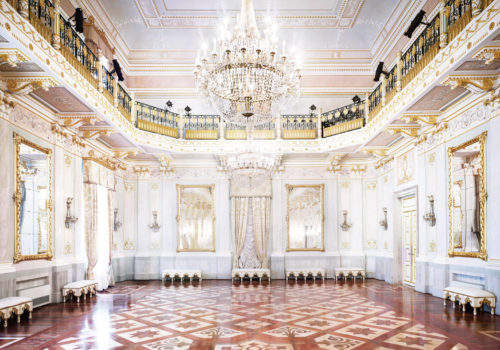On a rainy and cloudy Monday morning, with a post-Paris Photo mood, I headed to the Somerset House to visit Real Venice. An exhibition organised by the charity Venice in Peril, in collaboration with Ivorypress, to raise funds for the restoration and protection of buildings and art works in Venice. The show, curated by Ivorypress founder, Elena Foster and her team premiered at San Giorgio Maggiore Abbey on the occasion of the Biennale di Venezia this year and will be on display in London until the 11th of December. Real Venice, and the accompanying catalogue, are part of the CPhoto Project: a programme that aims at supporting and promoting photography and contemporary art through publications, exhibitions and other related activities.
Real Venice features fourteen internationally renown photographers—Lynne Cohen, Philip-Lorca diCorcia, Antonio Girbés, Nan Goldin, Pierre Gonnord, Dionisio González, Candida Höfer, Tiina Itkonen, Mimmo Jodice, Tim Parchikov, Matthias Schaller, Jules Spinatsch, Hiroshi Watanabe and Robert Walker—who have been asked to visit Venice and put together a portfolio of images to celebrate the city. Each artist contributed to the fundraising purpose by donating an edition of the portfolio. In addition, selected photographs from the collection have been included in a dedicated auction that was held at Phillips de Pury in London on the 3rd of November with all proceeds going to Venice in Peril.
The Somerset House is a spectacular neo-classical building home to the Courtauld Gallery and to a diverse programme of exhibitions. I entered the building from the Strand and crossed the courtyard—where the annual Ice Rink is about to open—to get to the Embankment Galleries located in the South Wing on the River Thames. The gallery space is a secluded and quiet area that allows the public to deeply focus on the exhibition.
The work of Hiroshi Watanabe, Marta Marchi as Strega—also used for the exhibition leaflet—welcomes the visitors and introduces a central theme to the Venetian culture, that of the mask. The Japanese photographer approached the project proposed by Venice in Peril studying the Commedia dell’Arte that, just like Japanese theater, uses masks on stage. Watanabe knew that both countries had similar vibrant theatrical traditions. He had been working on portrait series for a few years, eventually focusing on historical theatrical arts, and capturing Kabuki actors, Bunraku dolls, and Noh masks. Likewise, he became interested in doing portraiture in Venice: “…I sensed they [Venetians] are not perfectly happy with what is going on with the city. It seems the city exists for (as tourist attractions) and by (with tourists’ money) the outsiders. There seems to exist many who benefit from this flood of people but perhaps many more were pushed aside. I felt this friction, and I tried to bring in this conflicted tension into my photographs…”
On the upper floor I have found some of my favourite portfolios: Lynn Cohen’s, and Jules Spinatsch’s. Since the early 1970s, Cohen has been exploring the mystery of empty places where the space itself is a tangible subject in the image. Although here the human presence is still a haunting feeling that permeates the environment. Cohen avoids any contextualisation of the space in her photographs rather applies the power of ambiguity and absence. In her most recent series Vague Memories, Cohen documents the interiors of a struggling Venice focusing on the psychological, sociological and political aspects of the subjects. She refuses to convey a postcard-like image of Venice made of symbols of a past glory: interiors of churches, palaces or theaters. Her interiors remind staged sets or postmodern installations where we expect to see the actors appear any minute. “The disorientation her photographs provoke is largely the result of the specific and mysterious nature of the places she photographs with their odd symmetries and disjunctions.”
On the opposite wall is Jules Spinatsch’s portfolio, Exit Strategies. The wall text next to the images reads: “Hanna: Oh, Jeff, the world is bad. Jeff: The only thing I accept is despair”. The film is set in a hotel by the sea where the team is waiting in vain for the director and the star to arrive. Only the start of shooting will eventually bring relief to the psychological and emotional tension. Spinatch arrived in Venice in a similar mood to that of the characters of Fassbinder’s film Beware of a Holy Whore. He was hoping to find escape to his anguish in the city but the attempt ended up in an utter failure. He was progressively sinking in his personal darkness. Claustrophobia and the search for an escape became fundamental topics to explore: a common trait to Exit Strategies is the presence of the route of escape that is either barely visible or center stage in each image.
The collection of portfolios on display offers an alternative vision of Venice in all its complexity between different identities that try to complement and adjust to each other.
Elisa Badii
Real Venice
Somerset House
Embankment Galleries
London WC2R 1LA
10.00am-6.00pm
10.00am-8.00pm Thursdays
Until 11 December 2011
















